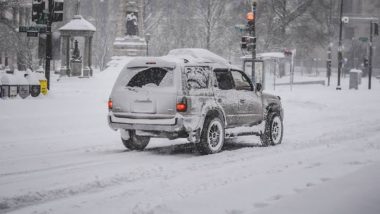Watsonville, March 12: A Northern California agricultural community famous for its strawberry crop was forced to evacuate early Saturday after the Pajaro River's levee was breached by flooding from a new atmospheric river that pummeled the state.
Across the Central Coast's Monterey County, more than 8,500 people were under evacuation orders and warnings Saturday, including roughly 1,700 residents — many of them Latino farmworkers — from the unincorporated community of Pajaro. California Storm: 13 People Found Dead Due to Winter Storms.
Officials said the Pajaro River's levee breach is about 100 feet (30.48 meters) wide. Crews had gone door to door Friday afternoon to urge residents to leave before the rains came but some stayed and had to be pulled from floodwaters early Saturday.
First responders and the California National Guard rescued more than 50 people overnight. One video showed a member of the Guard helping a driver out of a car trapped by water up to their waists. Also Read | US Health Agencies Debunk Florida Surgeon General Joseph Ladapo’s COVID-19 Vaccine Claims.
“We were hoping to avoid and prevent this situation, but the worst case scenario has arrived with the Pajaro River overtopping and levee breaching at about midnight," wrote Luis Alejo, chair of the Monterey County Board of Supervisors, on Twitter.
Alejo called the flooding “massive,” saying the damage will take months to repair. The Pajaro River separates the counties of Santa Cruz and Monterey in the area that flooded Saturday. Floodwaters that got into the region's wells might be contaminated with chemicals, officials said, and residents were told not to drink or cook with tap water for fear of illness.
Officials had been working along the levee in the hopes of shoring it up when it was breached around midnight Friday into Saturday. Crews began working to fix the levee around daybreak Saturday as residents slept in evacuation centers.
Oliver Gonzalez, 12, told The Associated Press that he, his mother and his aunt were rescued around 5 a.m. Saturday in Parajo. He grabbed his laptop, cellphone and some important documents but so much was left behind in their rush to leave.
“I'm kinda scared," he said several hours later from an evacuation center in nearby Watsonville. "My mom's car was left in the water.” Anais Rodriguez, 37, said first responders knocked on her home's door shortly after midnight. Her family packed about four days' worth of clothing and drove out to safety. She and her two children, her husband and her parents — along with their dog, Mila — arrived at the shelter about an hour later with few answers about what this would mean for their community going forward.
Gov. Gavin Newsom's office on Saturday said it was monitoring the situation in Pajaro. “Our thoughts are with everyone impacted and the state has mobilized to support the community,” the governor's office wrote on Twitter.
The Pajaro Valley is a coastal agricultural area known for growing strawberries, apples, cauliflower, broccoli and artichokes. National brands like Driscoll's Strawberries and Martinelli's are headquartered in the region.
In 1995, the Pajaro River's levees broke, submerging 2,500 acres (1,011 hectares) of farmland and the community of Pajaro. Two peopled died and the flooding caused nearly $100 million in damage. A state law, passed last year, advanced state funds for a levee project. It was scheduled to start construction in 2024.
State Sen. John Laird, who spearheaded the law and represents the area, said the project is fully funded now but it just came down to bad timing with this year's rains.
“It's tragic, we were so close to getting this done before any storms,” he said. This week's storm marked the state's 10th atmospheric river of the winter, storms that have brought enormous amounts of rain and snow to the state and helped lessen the drought conditions that had dragged on for three years.
State reservoirs that had dipped to strikingly low levels are now well above the average for this time of year, prompting state officials to release water from dams to assist with flood control and make room for even more rain.
Across the state on Saturday, Californians contended with drenching rains and rising water levels in the atmospheric river's aftermath. In Tulare County, the sheriff ordered residents who live near the Tule River to evacuate, while people near the Poso Creek in Kern County were under an evacuation warning. The National Weather Service's meteorologists issued flood warnings and advisories, begging motorists to stay off deluged roadways.
In San Francisco, an 85-foot (25.91 meter) eucalyptus tree fell onto the Trocadero Clubhouse early Saturday morning. The 1892 clubhouse, a San Francisco historical landmark, was left severely damaged, with part of the roof crushed and the inside flooded.
Funnel clouds were spotted in the Jamestown area — the heart of California's Gold Rush — on Saturday afternoon and the weather service issued a tornado warning for the Sierra Nevada foothills as thunderstorms and hail blanketed the region. There were no immediate reports of injuries or damage.
Democratic Gov. Gavin Newsom has declared emergencies in 34 counties in recent weeks, and the Biden administration approved a presidential disaster declaration for some on Friday morning, a move that will bring more federal assistance.
The atmospheric river, known as a “Pineapple Express” because it brought warm subtropical moisture across the Pacific from near Hawaii, was melting lower parts of the huge snowpack built in California's mountains.
(The above story is verified and authored by Press Trust of India (PTI) staff. PTI, India’s premier news agency, employs more than 400 journalists and 500 stringers to cover almost every district and small town in India.. The views appearing in the above post do not reflect the opinions of LatestLY)













 Quickly
Quickly


